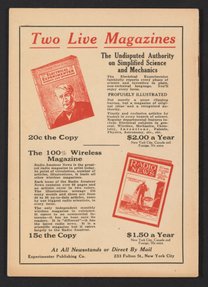Design and Construction of Audion Amplifying Transformers, Radio and Audio Types
Construction details and directions for making these two types of amplifying transformers
- 1920

Rights
Download all 20 images
PDFZIPof full-sized JPGsDownload selected image
Small JPG1200 x 1639px — 280 KBFull-sized JPG2314 x 3161px — 740 KBOriginal fileTIFF — 2314 x 3161px — 21.0 MBInformational pamphlet discussing audion transformers suitable for use in the construction of amplifiers. The transformer described is said to amplify audio signals up to four hundred times. Describes the construction, materials, and technical specifications of the radio frequency and audio frequency type transformers. Illustrated throughout. Work is digitized in its entirety.
| Property | Value |
|---|---|
| Author | |
| Publisher | |
| Place of publication | |
| Format | |
| Genre | |
| Extent |
|
| Language | |
| Subject | |
| Rights | Public Domain Mark 1.0 |
| Credit line |
|
Institutional location
| Department | |
|---|---|
| Collection | |
| Physical container |
|
Related Items
Cite as
Jones, Edward Thomas. “Design and Construction of Audion Amplifying Transformers, Radio and Audio Types.” New York, New York: The Experimenter Publishing Co., 1920. TK5865 .J66 1920. Science History Institute. Philadelphia. https://digital.sciencehistory.org/works/30vlzrd.
This citation is automatically generated and may contain errors.
/
Rights
Download all 20 images
Searchable PDFmay contain errorsZIPof full-sized JPGsDownload selected image
-
Keyboard Shortcuts
Previous image shift + or , Next image shift + or . Pan image Zoom in + or shift + Zoom out - or shift + Zoom to fit 0 Close viewer esc Also
Mouse click to zoom in; shift-click to zoom out. Drag to pan. Pinch to zoom on touch.
























